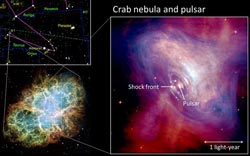‘Cold’ wind of the Crab pulsar produces very-high-energy gamma-ray pulses

Fig. 1: The Crab nebula (M1) in the Taurus constellation, taken by the Hubble space telescope (lower left). The details to the right are showing a composite of visible light (red) and X-rays (blue) with the pulsar as central star. At the shock front in 0.3 light-years distance from the pulsar, the ultrarelativistic wind of electrons and positrons collides with the surrounding nebula.<br>Graphics: MPIK, source: NASA<br>
Scientists around Felix Aharonian from the MPI for Nuclear Physics and the Dublin Institute for Advanced Studies now present an explanation for this radiation. It is based on the abrupt acceleration of an ultrafast wind of “cold” electrons and positrons, taking place at a distance of some Earth’s diameters from the pulsar. (Nature, 15.02.2012 online)
The Crab pulsar, a fast-rotating, highly magnetized neutron star, is a product of the historical supernova observed in the constellation Taurus in 1054 AD. Its mass amounts to 1.4 to 2 times that of the Sun and its diameter is only 28 to 30 km. Together with its surrounding nebula, it is one of the best investigated astronomical objects (Fig. 1).
The generally accepted paradigm postulates the existence of a relativistic wind of electrons and their antiparticles, positrons, which originates in the pulsar’s magnetosphere and terminates in the interstellar medium. The evolution of the wind is characterized by three consecutive processes (Fig. 2): At a distance of about 1000 km from the pulsar, the pulsar’s rotational energy is transformed into electromagnetic energy, which in turn is converted to kinetic energy of bulk motion, i.e. acceleration of the wind. Finally, the wind terminates by collision with matter in a standing reverse shock about 0.3 light years away. Thereby, the electrons and positrons are accelerated up to extremely high energies, resulting in an extended non-thermal source: the Crab nebula. All three processes need to proceed with incredibly high (close to 100 %) efficiency in order to explain the observational data.
Both the Crab pulsar and the Crab nebula are bright gamma-ray sources. While the pulsar emits in the high energies, the radiation of the nebula is released predominantly at the very-high-energy band. Meanwhile, the third key component, the wind, via which the transfer of energy from the pulsar to the nebula is realized, at first glance seems to be an ‘invisible substance’. Indeed, despite the relativistic speed of the wind, in the frame of the outflow the electrons are ‘cold’, meaning they move together with the wind’s magnetic field and therefore do not emit radiation. The wind, however, can radiate high-energy gamma-rays through the mechanism of inverse Compton scattering in which ultrafast electrons and positrons of the wind are illuminated by X-ray photons originating in the pulsar’s magnetosphere and/or the surface of the neutron star. In a paper published in Nature, Felix Aharonian, Sergey Bogovalov and Dmitry Khangulyan argue that recent reports of the surprise detection of pulsed, very-high-energy gamma radiation from Crab by the VERITAS and MAGIC atmospheric Cherenkov telescopes are best explained by inverse Compton scattering. Pulsed X-ray photons of the pulsar interact with ultrafast electrons of the wind predominantly in their acceleration zone. The wind, therefore, is the source of the pulsed gamma radiation and explains the observations with only three parameters: site of the acceleration of the wind, its final velocity, and the level of anisotropy.
If this interpretation is correct, then detection of the pulsed very-high-energy gamma-ray emission implies the first observational evidence of the formation of a cold ultrafast electron-positron wind from the Crab pulsar. The reported gamma-ray data allow us to localize, with a good precision, the site and estimate the speed with which the electromagnetic energy is transformed into the kinetic energy of the wind’s bulk motion. The results show that the acceleration of the wind to ultrarelativistic velocities should take place abruptly in a narrow cylindrical zone of radius between 20 and 50 thousand kilometers centered on the rotation axis of the pulsar. Although the ultrafast nature of the wind does support the general paradigm of pulsar winds, the requirement of the very fast acceleration of the wind in a narrow zone not very far from the pulsar challenges current models.
Weitere Informationen:
Original publication:
Abrupt acceleration of a 'cold' ultrarelativistic wind from the Crab pulsar
F. A. Aharonian, S. V. Bogovalov and D. Khangulyan
Nature, doi: 10.1038/nature10793
Contact:
Prof. Dr. Felix Aharonian
MPI für Kernphysik
phone: (+49)6221-516-485
e-mail: felix.aharonian (at) mpi-hd.mpg.de
Media Contact
More Information:
http://www.mpi-hd.mpg.deAll latest news from the category: Physics and Astronomy
This area deals with the fundamental laws and building blocks of nature and how they interact, the properties and the behavior of matter, and research into space and time and their structures.
innovations-report provides in-depth reports and articles on subjects such as astrophysics, laser technologies, nuclear, quantum, particle and solid-state physics, nanotechnologies, planetary research and findings (Mars, Venus) and developments related to the Hubble Telescope.
Newest articles

Security vulnerability in browser interface
… allows computer access via graphics card. Researchers at Graz University of Technology were successful with three different side-channel attacks on graphics cards via the WebGPU browser interface. The attacks…

A closer look at mechanochemistry
Ferdi Schüth and his team at the Max Planck Institut für Kohlenforschung in Mülheim/Germany have been studying the phenomena of mechanochemistry for several years. But what actually happens at the…

Severe Vulnerabilities Discovered in Software to Protect Internet Routing
A research team from the National Research Center for Applied Cybersecurity ATHENE led by Prof. Dr. Haya Schulmann has uncovered 18 vulnerabilities in crucial software components of Resource Public Key…





















